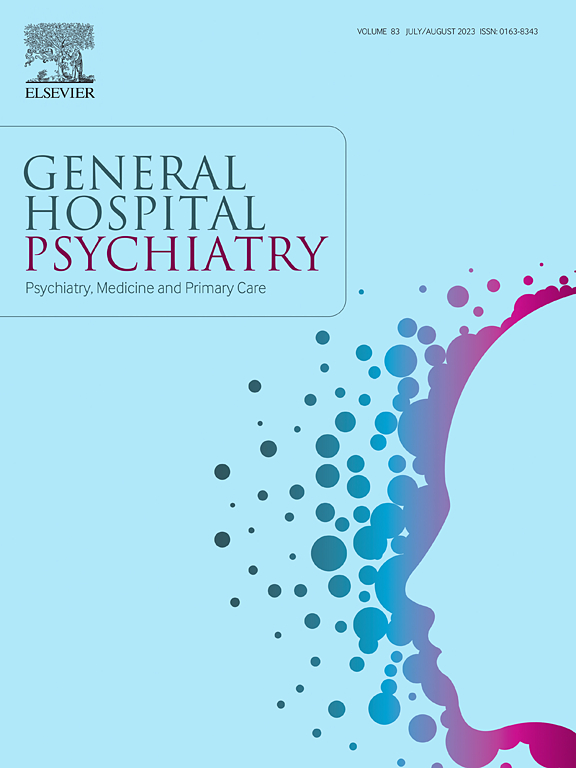经颅直流电刺激对阿片渴望的前额皮质调节:一项假对照双盲研究
IF 3.7
2区 医学
Q1 PSYCHIATRY
引用次数: 0
摘要
类鸦片成瘾是一项重大的全球健康危机,需要创新的治疗方法。本研究旨在探讨针对右背外侧前额叶皮层(DLPFC)的经颅直流电刺激(tDCS)在减少阿片类药物依赖个体的渴望中的效果。方法在这项单中心、双盲、随机、假对照试验中,40名阿片类药物依赖的男性住院患者被分配到右侧dlpfc活跃tDCS (2 mA, 20分钟)或连续5天的假刺激。在基线、治疗后立即、2周和4周随访时,通过强迫症药物使用量表(OCDUS)和成瘾严重程度指数(ASI)评估渴望和社会心理功能。重复测量方差分析检验组×时间差异。结果基线时,各组间OCDUS评分无差异(主动组:32.00±2.47 vs假手术组:31.60±2.85;F (1,38) = 0.582, p = 0.582, η2p = 0.015)。治疗后,活性组在第5天的渴望减少明显大于假组(10.35±2.21 vs. 24.25±5.29;F(1,38) = 956.5, p <;0.001,η2ₚ= 0.672)和14天(6.30±1.98和20.75±5.22;F(1,38) = 99.56, p <;0.001, η2ₚ= 0.503),效果维持在第28天(5.75±1.65 vs. 23.35±6.07)。结论与假手术相比,5次右侧dlpfc tDCS能快速、显著、持续地减少阿片类药物的渴望,支持其作为阿片类药物使用障碍辅助治疗的前景。本文章由计算机程序翻译,如有差异,请以英文原文为准。
Prefrontal cortex modulation using transcranial direct current stimulation in opioid craving: A sham-control double-blind study
Background
Opioid addiction, a major global health crisis, has necessitated innovative therapeutic approaches. This study aims to investigate the efficacy of Transcranial Direct Current Stimulation (tDCS) targeting the right dorsolateral prefrontal cortex (DLPFC) in reducing cravings among individuals with opioid dependence.
Method
In this single-centre, double-blind, randomized, sham-controlled trial, 40 male inpatients with opioid dependence at the Central Institute of Psychiatry (Ranchi, India) were allocated to either active right-DLPFC tDCS (2 mA, 20 min) or sham stimulation for five consecutive days. Craving and psychosocial functioning were assessed via the Obsessive–Compulsive Drug Use Scale (OCDUS) and Addiction Severity Index (ASI) at baseline, immediately post-treatment, and at 2- and 4-week follow-ups. Repeated-measures ANOVA tested group × time differences.
Results
At baseline, OCDUS scores did not differ between groups (Active: 32.00 ± 2.47 vs. Sham: 31.60 ± 2.85; F (1,38) = 0.582, p = 0.582, η2p = 0.015). Following treatment, the Active group showed markedly greater reductions in craving than Sham at Day 5 (10.35 ± 2.21 vs. 24.25 ± 5.29; F(1,38) = 956.5, p < 0.001, η2ₚ = 0.672) and Day 14 (6.30 ± 1.98 vs. 20.75 ± 5.22; F(1,38) = 99.56, p < 0.001, η2ₚ = 0.503), with effects maintained at Day 28 (5.75 ± 1.65 vs. 23.35 ± 6.07).
Conclusion
Five sessions of right-DLPFC tDCS produced rapid, significant, and sustained reductions in opioid craving compared with sham, supporting its promise as an adjunctive treatment in opioid use disorder.
求助全文
通过发布文献求助,成功后即可免费获取论文全文。
去求助
来源期刊

General hospital psychiatry
医学-精神病学
CiteScore
9.60
自引率
2.90%
发文量
125
审稿时长
20 days
期刊介绍:
General Hospital Psychiatry explores the many linkages among psychiatry, medicine, and primary care. In emphasizing a biopsychosocial approach to illness and health, the journal provides a forum for professionals with clinical, academic, and research interests in psychiatry''s role in the mainstream of medicine.
 求助内容:
求助内容: 应助结果提醒方式:
应助结果提醒方式:


